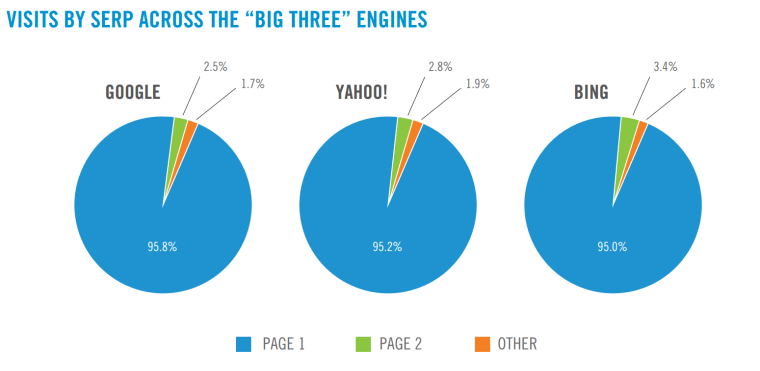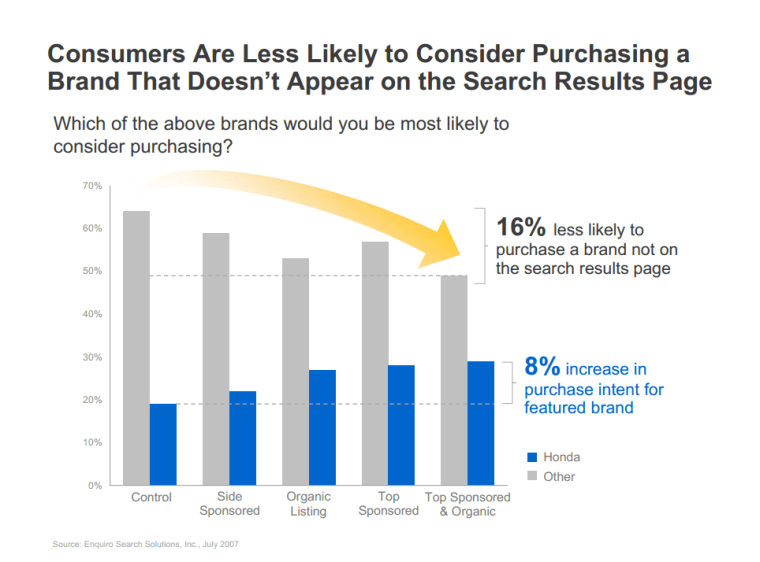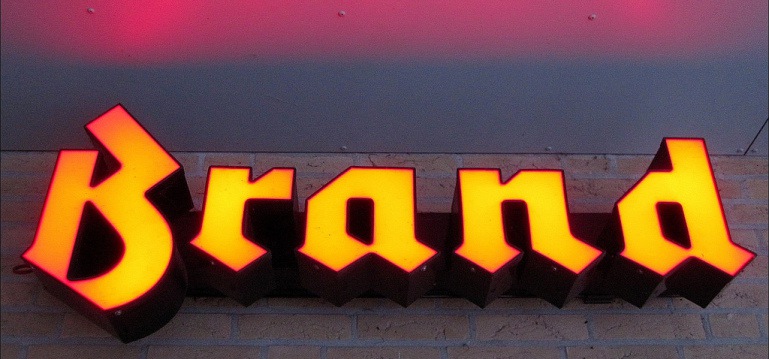Brands are like people: both have a physical structure, a name, a personality, and a reputation. Both can be respected or even loved, liked, and considered as part of our life or just simple accessories. Both brands and people can be regarded as dispensable or irreplaceable, principled or opportunistic, mature or constantly evolving with time. The way they are managed and developed is what differentiates and positions both people and brands.
The question we are trying to answer in this article is how ranking in Google can influence brand development and how a brand can take full advantage of its position in SERP.
Is It Only Traffic and Conversions?
Ranking high in Google is a moment of joy and delight for all site owners. While traffic and conversion rates are the most tracked indicators, a big benefit might be left out: brand development. As rankings and traffic fluctuate, the “brand” is a long race asset. You have to ask yourself: what would happen if starting tomorrow, search engines did not exist anymore? Will users be still looking for your website? Are you positioned strong enough in the mind of your consumer so he will be motivated to search you anywhere on the internet?
Of course, as the return on investment is the Holy Grail, traffic or conversion rates play a huge role in increasing sales, both offline and online. But the way the online activity influences the brand overall might not only generate a clear vision of how the brand is doing, but can actually give you inspiring hints about how your strategy should look like both online and offline.
Reputation Management
Brands exist because we have created and supported them. At the end of the day, the power is in the consumer’s hands, as it should be, and not in the search engines’ pocket.
Let me prove this: Even in the online world, a brand is made strong by the consumers. They are the one that made its presence possible in SERPs, which creates a self-fulfilling circle. This means the stronger a brand’s presence in Google is, the more it will be clicked, searched, and linked. Then, the more it will be clicked, the stronger the brand becomes in Google.
This perpetual motion is a little mind-blowing, but it tells us two important things: the whole system doesn’t just make brands rank higher in Google, but also increases the amount of trust a searcher perceives in the brand and, furthermore, it will increase the click-through rate of brands.
The Importance on Ranking on the First Page
There is no doubt that ranking on the first page is critical in the process of driving traffic to a site. Just take a look at the charts below extracted from an iCrossing study:
 Screenshot taken 1/19/2015 of http://www.icrossing.com/sites/default/files/page-one-visibility.pdf
Screenshot taken 1/19/2015 of http://www.icrossing.com/sites/default/files/page-one-visibility.pdfBut traffic is not the only thing. Concepts such as brand recall, brand quality, or purchase consideration are affected by the rank that the brand has in the search engines. The traditional branding development paradigm might need to be reconsidered, as research conducted by Enquire in collaboration with Google reveals that consumers are less likely to consider purchasing a brand that is not present in search results page. The same study stresses the fact that there is a 16% point increase in brand association when brand is in top ad and top organic listings.
 Screenshot taken 1/19/2015 at http://www.conscious.co.uk/cms/document/the_brand_lift_of_search.pdf
Screenshot taken 1/19/2015 at http://www.conscious.co.uk/cms/document/the_brand_lift_of_search.pdfHow to Increase your Brand with the Help of Search Engines
1. Improve Your Brand Perception in the SERPs
A consumer’s first experience with your brand in the online world is on the search engine results’ page. At this point, it doesn’t matter how high your conversion rate is or how interactive your site is. What matters is what the consumer sees when he makes a search query with your brand name included.
It takes just a moment to impress, maybe less than 7 seconds, as the famous researcher and clinical psychologist Linda Blair says, according to the Daily Mail. With every new search that returns your site in the results, the brand is mentally evaluated. These first impressions can be nearly impossible to reverse or undo, making those first experiences extremely important for setting the tone for all the relations that follow. So, being on the first page doesn’t only give you the possibility of being clicked, but also the possibility of creating a strong, good brand impression.
Recommendations
First of all, focus on the title and the description of your page as they are the first elements coming into contact with a user. Be sure they are suggestive and attractive, otherwise you might be losing a lot of “clicks” regardless of how good the content on your page is. You have to be sure that your title and your synopsis are things that people will actually click on when they see them on the search result.
You can use Data Highlighter, a free tool from Google Webmaster Tools, to ask Google to present your data more attractively in search results. For example, if your site contains event listings, you can use Data Highlighter to tag data (name, location, date, and so on) for the events on your site.
Another handy tool is Rich Snippets. Snippets refer to the few lines of text that appear under every search result. Their purpose is to give users a sense for what’s on the page and why it’s relevant to their query. Google’s tool can help you to create rich snippets by providing detailed information about your brand. For instance, the rich snippet for a bike shop can show the items carried in the shop, the price range, or the average review.
2. Strengthen Your Brand Reputation
In the traditional paradigm, brands were considered intangible concepts and their reputation was an unquantifiable result of a social evaluation. The digital world changes all these things. Nowadays, brand reputation is something more like “Brand 2.0.” A brand reputation strategy isn’t just a simple activity in the network but also one developed online communities, comments, discussions, etc.
[pullquote]Not only is the brand the one which submits high quality content but this role is also voluntary undertaken by the audience who becomes a brand “ambassador.”[/pullquote]
Let’s say your website is positioned among the first five results in the SERPs. That’s indeed a strong indicator that your brand is an authority in the field, but this is not enough to build a strong reputation. Your audience will evaluate your brand also according to social signals, comments and discussions on forums, reviews, and whatever other information they find about you. Showing up on the first page of the search engine is not the main indicator of authority and is not just a way of showing the world how much traffic you have.
Recommendations
A. Use Social Media Monitoring
Social media monitoring refers to the act of analyzing public online content. Monitoring your public reputation on a regular basis can be one of the best things you can do if you want to be in control with your brand reputation. However, this doesn’t mean that you have to supervise what people are talking about you only when it comes to a specific issue. You must monitor multiple keywords and topics constantly and consistently. Depending on the size of your business, a social media monitoring can be done with the help of free instruments, such as Google Alerts.
B. React Wisely
We often hear the saying : “there is no such thing as bad publicity,” a quote often assigned to the famous businessman P.T.Barnum. This might be valid when talking about pop stars, but not when talking about brands and companies.
Your online reputation is a collection of good and bad reviews, and a proper attitude doesn’t always mean reacting adequately to what people say about your brand, but also whether to react, how, and when. A delayed reaction can cost your business thousand of dollars and having a reaction where it isn’t necessary can have a negative impact on your brand’s notoriety.
C. Take Transparency Risk Into Consideration
Transparency is an asset whose importance needs to be understood by brands.
[pullquote]Being open, honest, straightforward, and sincere is a great attitude that brands should take into consideration. Yet, this attitude comes with a price.[/pullquote]
In the digital world, you need to know that your customers can tell you straight and uncensored what they really think about your brand. Therefore, the risk of reputation damage is very high. Accepting customers’ opinions is great but you need to be ready to face them right away.
D. Manage Your Negative Reviews
The online world allows everyone to express their opinion. Naturally, the positive reviews are the desired ones but in real life, negative reviews are pretty common. And, with certain limits, it is normal to be this way. You shouldn’t put too much energy in worrying about negative comments exist but you should rather focus on what you can do so that your positive reviews appear in front of the negative ones. You want that your clients’ “first date” with your brand to be a good experience and that’s why you need to take care that your positive reviews outperform the negative ones in most of the searches a possible client could do.
Let’s take Ripoff Report for instance, a consumer complaint website where anybody can post a report about any business or person. An email address and the author’s assertion that they are who they say they are is the only requirements a user must fulfill in order to post as many complaints as he/she wants, about anything that he/she wants. Once a complaint is posted, it will stay there forever and, as if that was not enough, pages from Ripoff Report rank very high in search engines. So, what can you do if your brand is on Ripoff Report list? Search engine optimization and public relations efforts. Ongoing efforts in this direction (high quality content, positive articles, media, etc.) can hopefully help you to push offending ripoff reports off the first pages of search engines search results.
Also, managing your negative reviews also refers to the way you react to them:
- Be emphatic and try to understand the customer’s point of view
- Try to be as polite and constructive as you can be
- Research the issue and, if possible, try to solve the reported problem
- Learn from your mistakes
- Don’t get stuck in the moment
- If you believe that a review is actually a competitor’s attack, or is malicious or groundless, try to remove that review
3. Use the Competition in Your Favor
There is only one thing worse than fighting with your enemies and that is fighting without them.[pullquote]Avis is only no. 2 in rent-a-car business. So why choose us? Because we try harder! – “We try harder” campaign [/pullquote]
A very good example to illustrate this is the way the brand Avis understood competition: In terms of brand development, being among the first in SERPs is an important benefit, a huge responsibility, and a great opportunity.
You have a vote of confidence from Google and if you want to sustain this position you’d better keep the bar high. People consider if Google ranks you high you are an authority for that specific query or niche. Being on the top of the search results is like a promise for offering top quality.
Take advantage of this position and do not mess it up once you get to the top of Google! This is beneficial both to you and your audience: you will be “obliged” to constantly do your best to develop and strengthen your brand and your audience will have a great search experience.
4. Influence People by Creating the Perception of Authority
Another great asset that you have when ranking among the first in Google for a variety of related queries is the fact that the searches perceive you as an authority in that niche. For instance, if for the search query “sport equipment,” “best sport equipment,” ” running shoes,” etc. you rank on the first page, you can be seen as an authority in the field of “sport equipment.” Consumers tend to extend established brand names into product categories so, when saying your brand name, users might automatically think of “sport equipment.”
Recommendation
In order to influence people’s perception of your brand’s authority, you can also focus on creating great content, not with the direct purpose of selling but with the aim of creating brand awareness. You can offer your consumers more than products. You can offer them valuable information, valid data and really useful content. Build your brand authority and sales will follow.
This might not generate immediate purchases, but it will reinforce your brand values, returning long-term emotional and financial benefits.
Conclusion
Brand development is an ongoing evolution, not a one-time exercise. A brand manager’s aim shouldn’t be just to appear on the first page of a search engine. Evaluate your Brand online strategies carefully. It is possible that you might need to shift gears.
Undoubtedly, showing up in Google’s page one brings several benefits but there are more hurdles to overcome for the internet marketer. In order to compete in today’s sophisticated digital world, brands must have a deep understanding of themselves and of a consumer’s perception.





